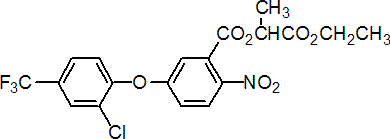|
lactofen
Herbicide
HRAC E WSSA 14; diphenyl ether

NOMENCLATURE
Common name lactofen (ANSI, WSSA)
IUPAC name ethyl O-[5-(2-chloro-a,a,a-trifluoro-p-tolyloxy)-2-nitrobenzoyl]-DL-lactate
Chemical Abstracts name (?-2-ethoxy-1-methyl-2-oxoethyl 5-[2-chloro-4-(trifluoromethyl)phenoxy]-2-nitrobenzoate
CAS RN [77501-63-4] unstated stereochemistry Development codes PPG-844
PHYSICAL CHEMISTRY
Composition Tech. is 74-79%. Mol. wt. 461.8 M.f. C19H15ClF3NO7 Form Dark brown to tan. M.p. 44-46 °C V.p. 9.3 ´ 10-3 mPa (20 °C) Henry 4.56 ´ 10-3 Pa m3 mol-1 (20°C, calc.) S.g./density 1.391 (25 °C) Solubility In water <1 mg/l (20 ºC). Stability No decomposition at ambient temperatures for 6 months. F.p. 93 °C
COMMERCIALISATION
History Herbicide introduced by PPG Industries in 1987. Manufacturers Milenia; Valent
APPLICATIONS
Biochemistry Protoporphyrinogen oxidase inhibitor. Mode of action Exhibits both pre-emergence and post-emergence activity. Uses Post-emergence control of broad-leaved weeds in cotton, soya beans and snap beans, at 0.2 lb/a. Registration for use on peanuts is pending. Formulation types EC. Selected products: 'Cobra' (Valent, Sumitomo, Bayer CropScience); 'Naja' (Milenia)
OTHER PRODUCTS
'Phoenix' (Valent); 'V10086' (Valent) mixtures: 'Stellar' (+ flumiclorac-pentyl) (Sumitomo, Valent)
MAMMALIAN TOXICOLOGY
Oral Acute oral LD50 for rats >5000 mg/kg. Skin and eye Acute percutaneous LD50 for rats 2000 mg/kg. Formulation severely irritating to eyes. Inhalation LC50 (4 h) for rats >5.3 mg/l. Toxicity class EPA (formulation) IV
ECOTOXICOLOGY
Birds LD50 for quail >2510 mg/kg. LC50 for ducks and quail >5620 ppm. Fish LC50 (96 h) for bluegill sunfish and rainbow trout >100 ppb. Daphnia LD50 >100 ppb. Bees LD50 (contact) >160 mg/bee.
ENVIRONMENTAL FATE
Soil/Environment Microbially degraded, DT50 3-7 d. Koc 10 000.
|